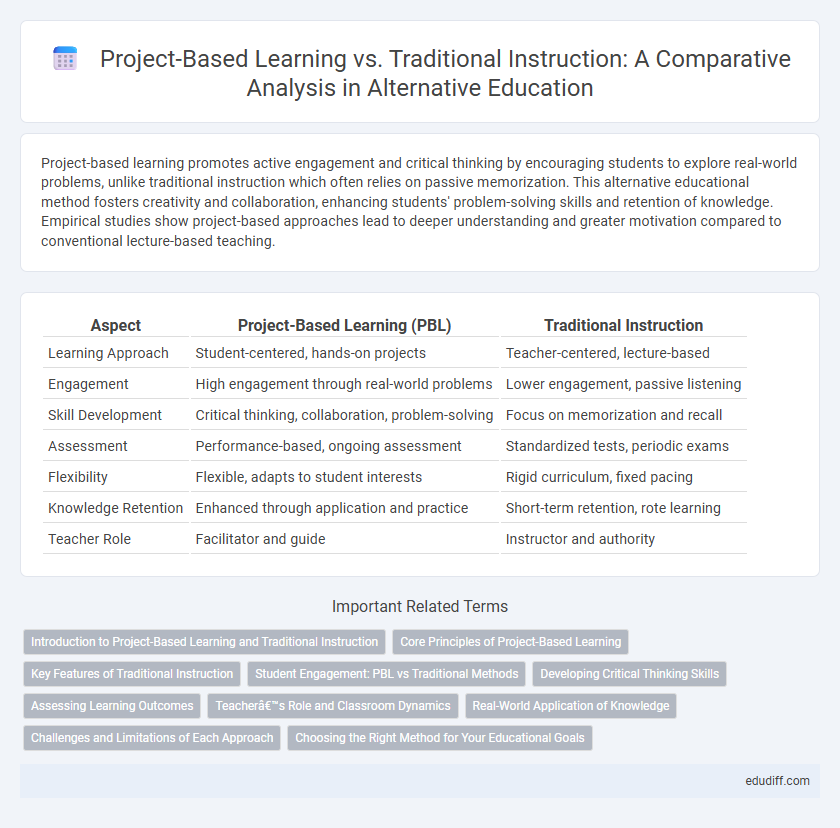Project-based learning promotes active engagement and critical thinking by encouraging students to explore real-world problems, unlike traditional instruction which often relies on passive memorization. This alternative educational method fosters creativity and collaboration, enhancing students' problem-solving skills and retention of knowledge. Empirical studies show project-based approaches lead to deeper understanding and greater motivation compared to conventional lecture-based teaching.
Table of Comparison
| Aspect | Project-Based Learning (PBL) | Traditional Instruction |
|---|---|---|
| Learning Approach | Student-centered, hands-on projects | Teacher-centered, lecture-based |
| Engagement | High engagement through real-world problems | Lower engagement, passive listening |
| Skill Development | Critical thinking, collaboration, problem-solving | Focus on memorization and recall |
| Assessment | Performance-based, ongoing assessment | Standardized tests, periodic exams |
| Flexibility | Flexible, adapts to student interests | Rigid curriculum, fixed pacing |
| Knowledge Retention | Enhanced through application and practice | Short-term retention, rote learning |
| Teacher Role | Facilitator and guide | Instructor and authority |
Introduction to Project-Based Learning and Traditional Instruction
Project-Based Learning (PBL) emphasizes active, hands-on collaboration where learners engage in real-world problems, fostering critical thinking and creativity. Traditional Instruction relies on direct teaching methods, focusing on lectures, memorization, and standardized assessments to deliver content efficiently. PBL introduces dynamic, student-centered experiences contrasted with the structured, teacher-led approach of Traditional Instruction, promoting deeper understanding and skill application.
Core Principles of Project-Based Learning
Project-Based Learning (PBL) centers on student-driven inquiry, collaboration, and real-world problem-solving, contrasting with Traditional Instruction's teacher-led, passive knowledge delivery. PBL emphasizes sustained engagement, authentic assessment, and integration of interdisciplinary skills to foster deeper understanding and critical thinking. Core principles include meaningful projects, iterative reflection, and public presentation of results, promoting active learning and practical application.
Key Features of Traditional Instruction
Traditional instruction emphasizes a structured curriculum delivered through teacher-led lectures, focusing on memorization and standardized testing to assess student performance. It prioritizes uniformity, with clearly defined learning objectives and a fixed pace that suits the majority of learners. Classroom environments typically rely on direct instruction, individual assignments, and frequent evaluations to maintain rigor and control.
Student Engagement: PBL vs Traditional Methods
Project-Based Learning (PBL) significantly enhances student engagement by promoting active participation, collaboration, and real-world problem-solving, unlike traditional instruction that often relies on passive reception through lectures and rote memorization. Research indicates students involved in PBL demonstrate higher motivation, deeper understanding, and improved critical thinking skills due to hands-on activities and meaningful projects. In contrast, traditional methods may lead to lower engagement levels and reduced retention as students are less involved in the learning process.
Developing Critical Thinking Skills
Project-Based Learning fosters critical thinking skills by engaging students in real-world problem solving, encouraging analysis, evaluation, and synthesis of information. Traditional instruction often relies on rote memorization, limiting opportunities for students to develop deeper cognitive skills necessary for critical thinking. Research shows that students in project-based environments demonstrate higher proficiency in reasoning and decision-making compared to those in conventional classroom settings.
Assessing Learning Outcomes
Project-Based Learning (PBL) emphasizes real-world application and critical thinking in assessing learning outcomes, using diverse methods such as presentations, portfolios, and peer evaluations to capture student understanding. Traditional instruction typically relies on standardized tests and quizzes that measure rote memorization and discrete skill acquisition. PBL assessments provide a more comprehensive evaluation of student abilities by integrating problem-solving skills and collaborative competencies.
Teacher’s Role and Classroom Dynamics
In project-based learning, the teacher acts as a facilitator, guiding students through collaborative problem-solving and real-world applications, which fosters active engagement and critical thinking. Traditional instruction positions the teacher as the primary source of knowledge, emphasizing direct instruction and individual work, resulting in more structured and teacher-centered classroom dynamics. Project-based classrooms encourage peer interaction and student autonomy, while traditional settings often maintain a more hierarchical and controlled environment.
Real-World Application of Knowledge
Project-Based Learning emphasizes the practical application of knowledge by engaging students in solving real-world problems, fostering critical thinking and collaboration skills. Traditional instruction often focuses on theoretical understanding, which can limit immediate relevance to everyday challenges and professional environments. Embedding authentic tasks in Project-Based Learning enhances student motivation and prepares them for real-life decision-making and problem-solving scenarios.
Challenges and Limitations of Each Approach
Project-Based Learning faces challenges like time-intensive planning and assessment difficulties, often requiring significant resources and teacher training. Traditional Instruction limits student engagement and critical thinking, with its reliance on rote memorization and passive learning. Both approaches struggle with scalability and adapting to diverse learner needs in varying educational contexts.
Choosing the Right Method for Your Educational Goals
Project-based learning enhances critical thinking and real-world problem-solving skills, making it ideal for fostering creativity and collaboration in students. Traditional instruction emphasizes structured content delivery and foundational knowledge, suitable for standardized testing and sequential learning objectives. Selecting the appropriate method depends on educational goals, such as prioritizing skill development versus content mastery.
Project-Based Learning vs Traditional Instruction Infographic

 edudiff.com
edudiff.com